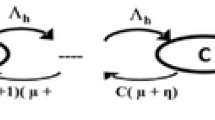Abstract
We propose a dynamic joint scheduling and call admission control (CAC) scheme for service classes defined in IEEE 802.16 standard. Using priority functions, equipped with service weights and service arrival rates, the proposed scheduling scheme differentiates service classes from each other. Based on obtained priority values, we first allocate the achievable bandwidth proportionally. Within individual service classes, we then use appropriate local schedulers to transmit packets accordingly. Moreover, instead of immediate admitting or blocking a new connection request, the proposed CAC scheme computes the average transmission rate that can be allocated to that connection during a time interval. The connection is admitted if its required rate is satisfied while at the same time QoS requirements of ongoing connections are not violated. Our numerical results demonstrate the effectiveness of the proposed schemes compared to the other schemes in the literature.
Similar content being viewed by others
Explore related subjects
Discover the latest articles, news and stories from top researchers in related subjects.References
IEEE Standard 802.16e™-2005 (2005). IEEE standard for local and metropolitan area networks—part 16: air interface for fixed and mobile broadband wireless access systems. Dec.
Eklund, C., Stanwood, K. L., & Wang, S. (2002). IEEE standard 802.16: a technical overview of the wireless MAN air Interface for broadband wireless access. IEEE Communications Magazine, 40(6), 98–107.
Delicado, J., Delicado, F. M., & Barbosa, L. O. (2008). Study of the IEEE 802.16 contention-based request mechanism. Telecommunication Systems Journal, 38(1–2), 19–27.
Ahmed, M. H. (2005). Call admission control in wireless networks: a comprehensive survey. IEEE Communications Surveys and Tutorials, 7(1), 50–69.
Cicconetti, C., Erta, A., Lenzini, L., & Mingozzi, E. (2007). Performance evaluation of the IEEE 802.16 MAC for QoS support. IEEE Transactions on Mobile Computing, 6(1), 26–38.
Sagar, & Das, D. (2008). Modified EDF algorithm and WiMAX architecture to ensure end-to-end delay in multihop network. In IEEE TENCON.
Jalali, A., Padovani, R., & Pankaj, R. (2000). Data throughput of CDMA-HDR a high efficiency high data rate personal communication wireless system. In IEEE VTC.
Demers, K. S., & Shenker, S. (1989). Analysis and simulation of a fair queuing algorithm. In SIGCOMM.
Andrews, M., Kumaran, K., Ramanan, K., Stolyar, A., & Whiting, P. (2001). Providing quality of service over a shared wireless link. IEEE Communications Magazine, 32(9), 150–154.
Pla, V., Virtamo, J., & Martinez, J. (2008). Optimal robust policies for bandwidth allocation and admission control in wireless network. Computer Networks, 52(17), 3258–3272.
Hu, F., & Sharma, N. K. (2003). Multimedia call admission control in mobile networks: a dynamical reservation-pool approach. Computer Networks, 43(3), 263–288.
Yee, Y. C., Choong, K. N., & Low, L. Y. (2007). A conservative approach to adaptive call admission control for QoS provisioning in multimedia wireless networks. Computer Communications, 30(2), 249–260.
Wang, H., He, B., & Agrawal, D. P. (2006). Above packet level admission control and bandwidth allocation for IEEE 802.16 wireless MAN. Simulation Modelling Practice and Theory, 15, 366–382.
Tsai, T.-C., Jiang, C.-H., & Wang, C.-Y. (2006). CAC and packet scheduling using token bucket for IEEE 802.16 networks. Journal of Communication, 1(2), 30–37.
Wongthavarawat, K., & Ganz, A. (2003). Packet scheduling for QoS support in IEEE 802.16 broadband wireless access systems. International Journal of Communication Systems, 16, 81–96.
Niyato, D., & Hossain, E. (2007). QoS aware bandwidth allocation and admission control in IEEE 802.16 broadband wireless access networks: a non-cooperative game theoretic approach. Computer Networks, 51(11), 3305–3321.
Qiu, X., & Chawla, K. (1999). On the performance of adaptive modulation in cellular systems. IEEE Transactions on Communications, 47(6), 884–895.
Rashidi-Bajgan, S., Taheri, H., Sabaghi, M., & Fathi, M. (2010). A new call admission control algorithm for IEEE 802.16 networks. In International conference on computer design and application (Vol. 4, pp. 361–365).
Author information
Authors and Affiliations
Corresponding author
Rights and permissions
About this article
Cite this article
Fathi, M., Rashidi-Bajgan, S., Khalilzadeh, A. et al. A dynamic joint scheduling and call admission control scheme for IEEE 802.16 networks. Telecommun Syst 52, 195–202 (2013). https://doi.org/10.1007/s11235-011-9555-8
Published:
Issue Date:
DOI: https://doi.org/10.1007/s11235-011-9555-8




